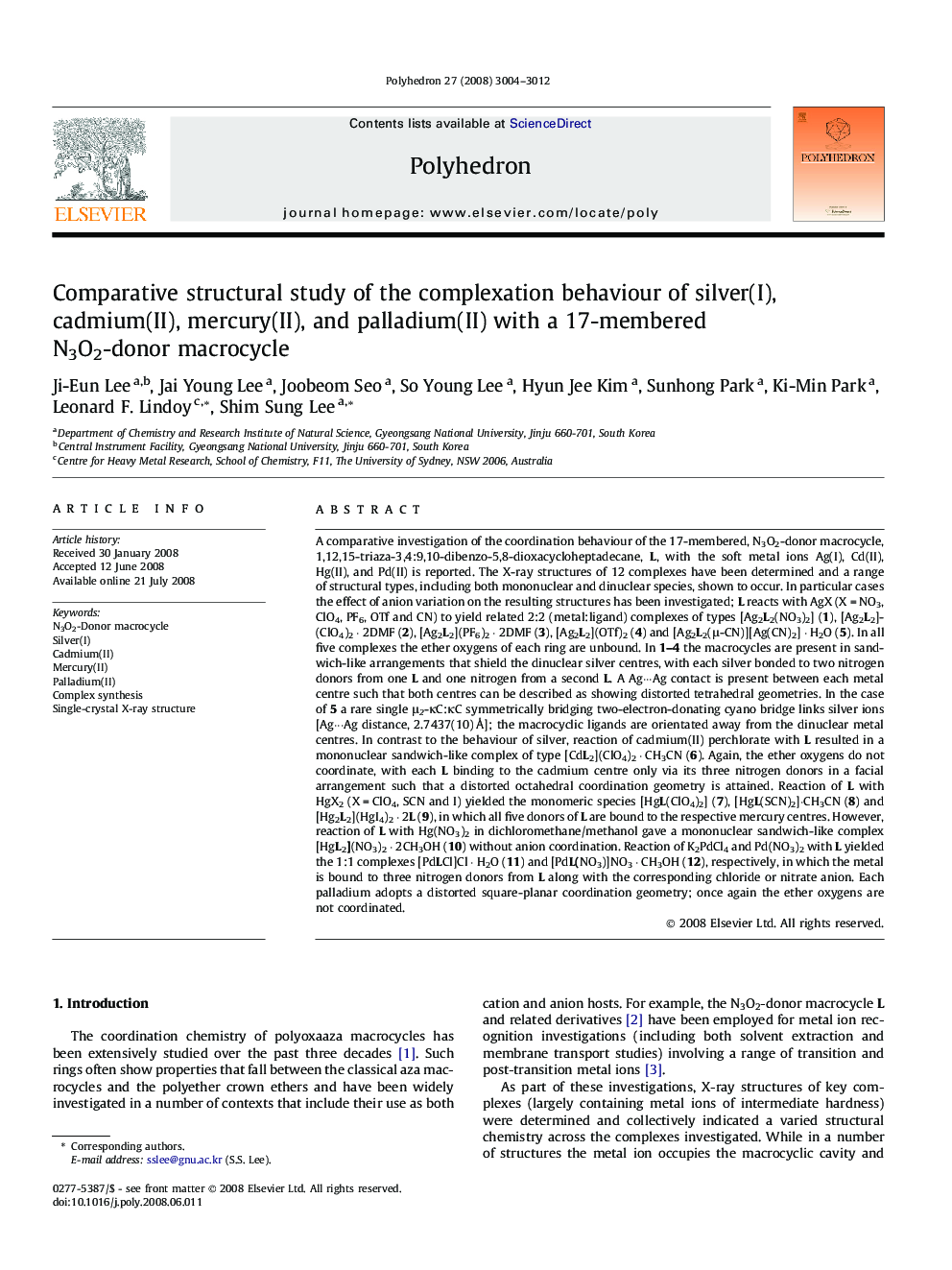| کد مقاله | کد نشریه | سال انتشار | مقاله انگلیسی | نسخه تمام متن |
|---|---|---|---|---|
| 1340370 | 979732 | 2008 | 9 صفحه PDF | دانلود رایگان |

A comparative investigation of the coordination behaviour of the 17-membered, N3O2-donor macrocycle, 1,12,15-triaza-3,4:9,10-dibenzo-5,8-dioxacycloheptadecane, L, with the soft metal ions Ag(I), Cd(II), Hg(II), and Pd(II) is reported. The X-ray structures of 12 complexes have been determined and a range of structural types, including both mononuclear and dinuclear species, shown to occur. In particular cases the effect of anion variation on the resulting structures has been investigated; L reacts with AgX (X = NO3, ClO4, PF6, OTf and CN) to yield related 2:2 (metal:ligand) complexes of types [Ag2L2(NO3)2] (1), [Ag2L2](ClO4)2 · 2DMF (2), [Ag2L2](PF6)2 · 2DMF (3), [Ag2L2](OTf)2 (4) and [Ag2L2(μ-CN)][Ag(CN)2] · H2O (5). In all five complexes the ether oxygens of each ring are unbound. In 1–4 the macrocycles are present in sandwich-like arrangements that shield the dinuclear silver centres, with each silver bonded to two nitrogen donors from one L and one nitrogen from a second L. A Ag···Ag contact is present between each metal centre such that both centres can be described as showing distorted tetrahedral geometries. In the case of 5 a rare single μ2-κC:κC symmetrically bridging two-electron-donating cyano bridge links silver ions [Ag···Ag distance, 2.7437(10) Å]; the macrocyclic ligands are orientated away from the dinuclear metal centres. In contrast to the behaviour of silver, reaction of cadmium(II) perchlorate with L resulted in a mononuclear sandwich-like complex of type [CdL2](ClO4)2 · CH3CN (6). Again, the ether oxygens do not coordinate, with each L binding to the cadmium centre only via its three nitrogen donors in a facial arrangement such that a distorted octahedral coordination geometry is attained. Reaction of L with HgX2 (X = ClO4, SCN and I) yielded the monomeric species [HgL(ClO4)2] (7), [HgL(SCN)2]·CH3CN (8) and [Hg2L2](HgI4)2 · 2L (9), in which all five donors of L are bound to the respective mercury centres. However, reaction of L with Hg(NO3)2 in dichloromethane/methanol gave a mononuclear sandwich-like complex [HgL2](NO3)2 · 2CH3OH (10) without anion coordination. Reaction of K2PdCl4 and Pd(NO3)2 with L yielded the 1:1 complexes [PdLCl]Cl · H2O (11) and [PdL(NO3)]NO3 · CH3OH (12), respectively, in which the metal is bound to three nitrogen donors from L along with the corresponding chloride or nitrate anion. Each palladium adopts a distorted square-planar coordination geometry; once again the ether oxygens are not coordinated.
An investigation of the coordination behaviour of the N3O2 macrocycle, L, with Ag(I), Cd(II), Hg(II), and Pd(II) is reported. The X-ray structures of 12 complexes were determined and a range of structural types, including mono- and dinuclear species, shown to occur.Figure optionsDownload as PowerPoint slide
Journal: Polyhedron - Volume 27, Issue 13, 10 September 2008, Pages 3004–3012